The new combustion conversation
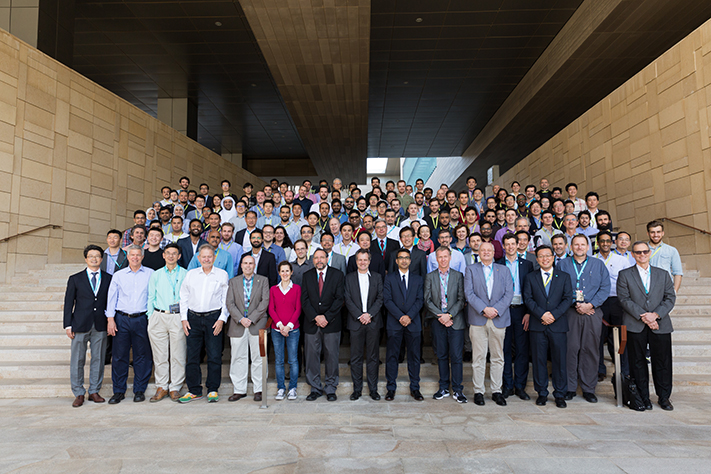
The 2017 KAUST Research Conference: New Combustion Concepts brought together leading experts from academia, national laboratories and industry to discuss all matters related to new combustion concepts. Photo by Lilit Hovhannisyan.
The three-day conference, which was organized by the Clean Combustion Research Center (CCRC), investigated combustion research centered around specific areas, including plasma-assisted; electrically assisted; advanced engine; novel engine; and new combustion technology. The event featured 21 invited contributions from renowned combustion experts, along with a poster session.
In his opening address, Professor William Roberts, director of the CCRC, welcomed the guests and spoke of the need to promote international collaboration with the global research community to discover new ideas towards clean and efficient combustion systems.
“We look forward to building relationships—we have to work extra hard to build collaborations here because of our location. It's harder to build collaborations here than in the U.S. or Europe,” he said.
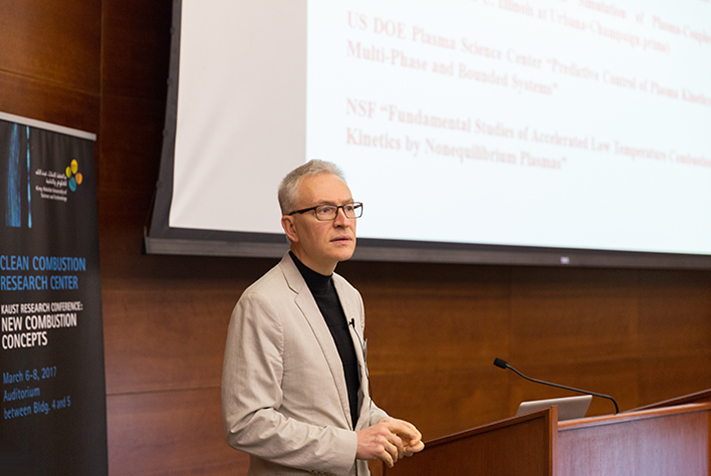
Professor Igor Adamovich, Department of Mechanical and Aerospace Engineering, Ohio State University, spoke about energy conversion. Photo by Lilit Hovhannisyan.
Mechanisms behind energy conversion
Igor Adamovich, a professor in the Department of Mechanical and Aerospace Engineering at Ohio State University, spoke about energy conversion in transient molecular plasmas at high specific loading in his conference opening presentation.“We want to find out the mechanisms behind energy conversion. When it comes to electron detection and electron temperature measurements, measurements in a flame are more challenging,” Adamovich said.
Following on from Adamovich, Anne Bourdon from the Laboratoire de Physique de Plasmas at École Polytechnique presented her address on plasma-assisted applications. Bourdon spoke on her team’s work examining the influence of fuel on the nanosecond discharge structure in different fuel/air mixtures.
“Our research is quite a challenge from a numerical point of view. Fuel doesn't change as many things in comparison to air. Through our research, we are trying to give more conclusive results to the combustion community,” Bourdon said.
Also on the first day of the conference, Yiguang Ju from Princeton University discussed the kinetic effects of plasma on ignition and flame stabilization.
“Plasma can enhance combustion, particularly at a low temperature—there is magic to plasma-assisted combustion applications. It seems like plasma really works and works efficiently, and coupling plasma with combustion enhances the ignition process," Ju explained. "With plasma, you can break down the ignition limits, and it is more effective to activate low-temperature chemistry and enable cool flames and engine-ignition control. Plasma directly enhances ignition and can reduce minimum-ignition energy, but it seems to have less impact on flames."
“For engine applications, development of high-pressure volumetric, non-equilibrium plasma discharge is the key,” he added.
‘The embodiment of fundamental chemistry’
Mani Sarathy, KAUST associate professor of chemical engineering, described the ongoing work and cutting-edge research carried out in the CCRC and the role his research plays in it. His conference presentation was centered on filling the gaps between neutral and ion chemistry in premixed flames.“You always have to start at a fundamental level—we try to make models to predict behavior. I like to work with different types of fuels for different applications. Our models tell a story that can be used to understand the combustion process. Our models need to be the embodiment of some fundamental chemistry that is happening,” Sarathy said.
“I personally try to contribute by predicting the chemistry. There are several motivations for ion chemistry. Flames contain positive ions, negative ions and electrons that are produced by a chemi-ionization process. People have been looking at flames for a long time, and the rates are poorly known for many of these reactions,” he noted.
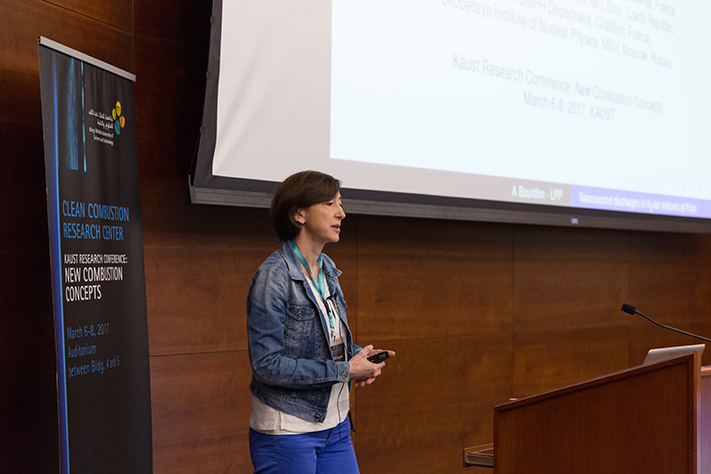
Anne Bourdon from the Laboratoire de Physique de Plasmas at École Polytechnique presented her address on plasma-assisted applications. Photo by Lilit Hovhannisyan.
Re-examining old concepts
Joseph Shepherd, C. L. "Kelly" Johnson professor of aeronautics and mechanical engineering at Caltech, explained his research involving hot surface ignition experiments and modelling.“It's not always clear what ignition is—we have spent the last 20 years or so working on ignition and things that happen in industrial facilities connected to accidental ignition. The area of low-temperature chemistry is often in play, and temperature is often used as a criterion for auto ignition. We are examining what it means to have a very large transition that takes place over large surface areas,” Shepherd explained. “I am talking about old combustion but I hope some new concepts will come from re-examining these old concepts.”
An ability to manage current challenges
Day two of the conference saw Staffan Lundgren from Volvo Group Truck Technology in Sweden describe the need for high-efficiency diesel engines for long-haul trucks. Lundgren and his team created a Super Truck combustion system needed to meet the challenges of European heavy-duty transport, and he recounted his team’s efforts in exploring the need for, and usage of, alternative fuels in the future, such as electro fuels and sun fuels.“We have created a new piston shape and the dual compression/expansion engine. We work with high-loaded engines for marine applications, for example, and we also work to produce truck-racing engines. With aerodynamics and rolling resistance, you can downsize the engine,” Lundgren said.
“You need to find a solution for emission control and find a solution where emission is acceptable. We are now running into ultra-low emissions, even for trucks. This is a challenge because making the system work at lower temperatures is difficult. Rapid advances in engine technologies are enabling new efficiency opportunities. It is a challenge to select the best alternative fuels and there is still a lot of interesting work to do,” he noted.
Advances in technology
Robert Wagner, director of the Fuels, Engines and Emissions Research Center at Oak Ridge National Laboratory, analyzed reactivity stratification enabled combustion in his conference talk.“One thing that has really resonated with me is how technology has changed over the last 10 years. Engines have changed a lot and much progress has been made with them. Technology advances are driving faster and smarter controls. With all of the technology advances, we have new areas that we can investigate,” Wagner stated.
“There are now improved sensors, increased onboard computing power and more flexible components. Also, there are many unintended benefits from hybrid configurations. Things have exploded in what we are able to do,” he added.
Wagner went on to discuss low temperature combustion (LTC) and how it blends the best characteristics of diesel and SI combustion for high efficiency with low emissions.
“Reactivity controlled compression ignition makes use of two fuels, and this provides flexible control over combustion phasing and rate—a multi fuel approach expands reactivity stratification potential. Rapid advances in engine technologies are enabling new efficiency opportunities,” he said.
Combustion’s key role
Cherian Idicheria from General Motors opened the final day of the event by covering low-temperature plasma ignition and the area of corona ignition tests. Idicheria was followed by Derek Dunn-Rankin from the University of California, Irvine, who discussed the electrical aspects of flames, burning hydrates and miniature combustors.“When we try to make a hydrate, it doesn't form sweetly. You never know what you are going to get. It takes eight to 20 hours to get a hydrate—this is a typical nucleation frustration problem,” Dunn-Rankin said.
In his presentation “High-flying combustion: keeping airplanes safe,” Jason Damazo from The Boeing Company, described in the crucial role combustion plays in air travel and transport in the 21st century. He also highlighted the combustion research areas of interest to Boeing, including jet engines, rocket engines, fuels development and safety.
“We do structure interaction and combustion and we look at proving that things are safe to various types of combustion and explosion loading. We prove whether or not different safety components related to combustion are viable,” Damazo explained.
He noted that air travel is by far the safest mode of transport and travel compared to the other standard forms of transport (the likelihood of death from an airplane crash is one in 11 million versus rail at one in 500,000 and automobile at one in 8,000).
“Airplanes have a very impressive track record and they are also built to survive crashes. In fuel system development, a lot of systems have gone into making planes safe. If a new technology can make planes safer, that is what really resonates. Developing a quantitative interest in safety is both hard and fun,” he said.
“To show to the FAA (U.S. Federal Aviation Administration) that a system is safe, we compare it to an old system that has been flying for years. A new aircraft has to be shown that it is as safe as its predecessors. There must be at least two independent methods of preventing catastrophic failure when other
systems do fail.
“Improving the regulations of how safe is safe has been one of our success stories from a quantitative standpoint. The threat of all ignition sources is not identical and we look at what causes ignition for a range of different mechanisms. The temperature required to cause ignition changes rapidly with the size of the heat source. Boeing seeks to acquire a quantitative understanding of ignition under a range of operating conditions,” Damazo added.
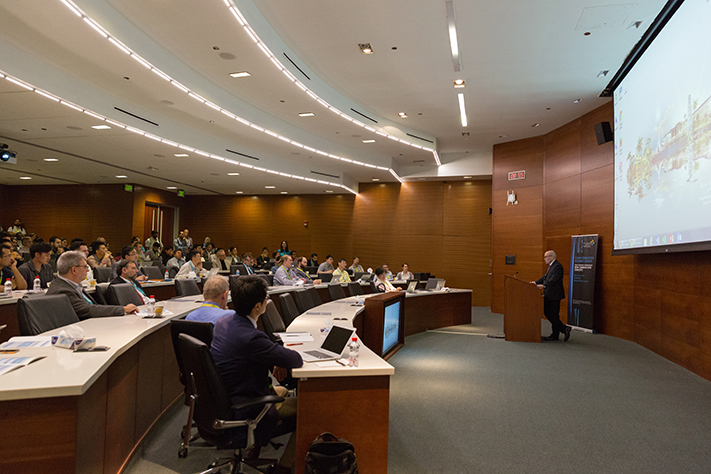
Professor William Roberts, director of the CCRC, during his opening address to attendees. Photo by Lilit Hovhannisyan.
An electric future?
In his conference address, Lucien Koopmans from Volvo and Chalmers University, Sweden, discussed the Euro seven diesel emission system and low cooling loss combustion (LCLC) and posed the question of whether the internal combustion engine will eventually be replaced by electric motors.“There are too many hurdles for electrical vehicles right now—electric cars are quite expensive in Europe at around €76,000 compared to a combustion engine vehicle at €58,000. The cost of electric vehicles is so high, so there must be some combustion in the future—but you have to have that technological solution as well, ” he said.
“The future is very unpredictable and the share of electrification will differ widely in the year 2030 in different scenarios. There is a lot of media attention towards getting rid of internal combustion engines, especially in Europe. We have to do something about the perception of internal combustion engine vehicles—we have to make these cars better. 50 percent engine efficiency over the whole driving cycle should be our challenge,” Koopmans added.
“We have to think on a system level here—we have to regard the internal combustion engine as part of vehicle consumption/performance. The internal combustion engine has to become an alternative to the electric motor, and then you might survive for the future,” he concluded.
Wayne Eckerle, V.P. of corporate R&T, Cummins (US) echoed the sentiments of Koopmans as he spoke about the move from carbon-based fuels to clean, renewable fuels, but cautioned that the move will take time and further research and development.
“No new fuels are coming, but electrification is coming, so we are looking to make lower-cost fuel systems as electrification is becoming a way of life,” Eckerle said.
‘Successful in generating conversations and potential collaborations’
William Roberts, director of the KAUST Clean Combustion Research Center, brought the New Combustion Concepts conference to a close by thanking all those who had helped to host and create the conference as well as the international guests for attending and collaborating over the duration of the conference.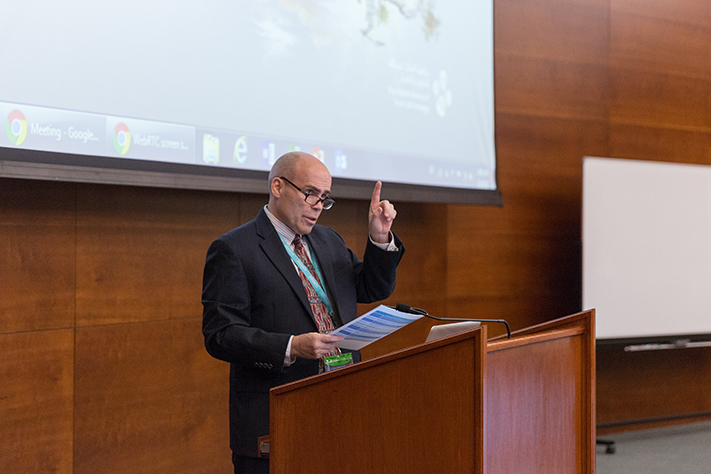
Professor William Roberts, director of the CCRC, during his closing address to the conference attendees. Photo by Lilit Hovhannisyan.
“This conference was a bit of an experiment in that we brought together two communities that don’t ordinarily have much overlap. I think it was remarkably successful in generating conversations and potential collaborations,” Roberts said.

